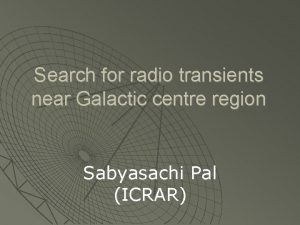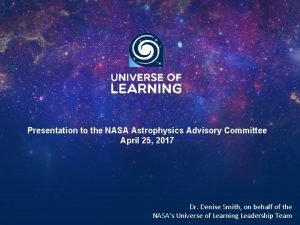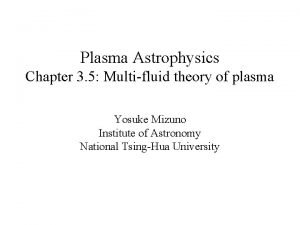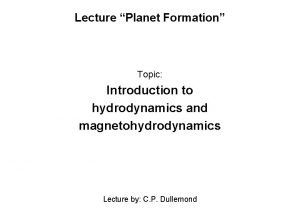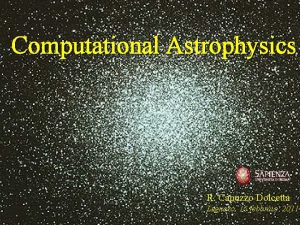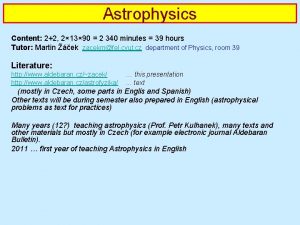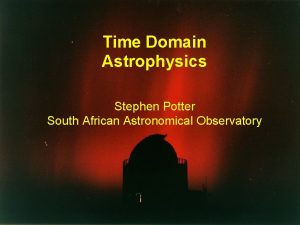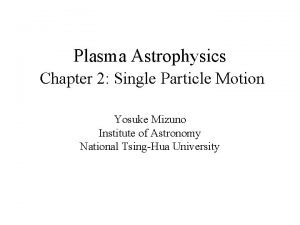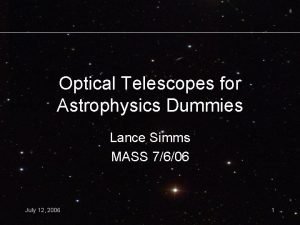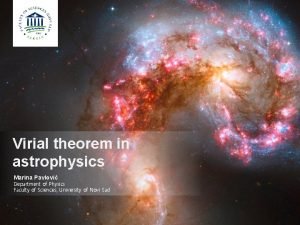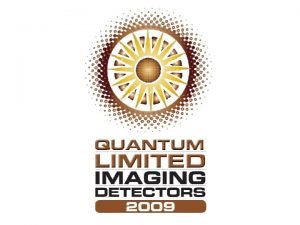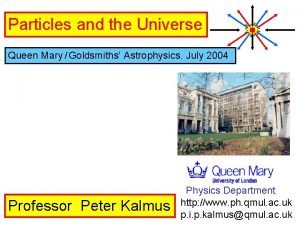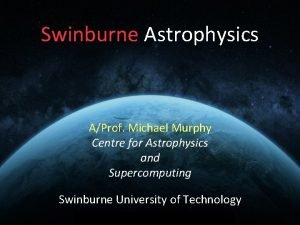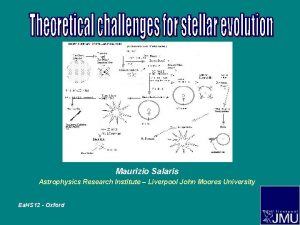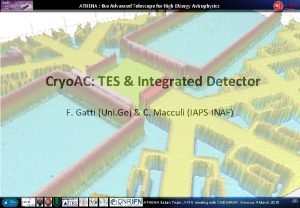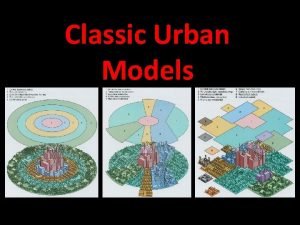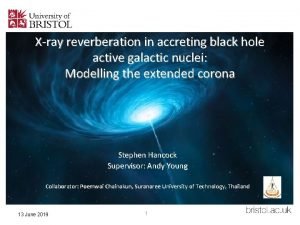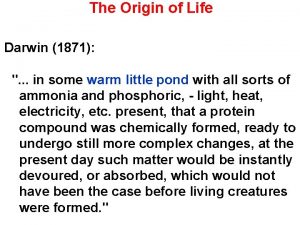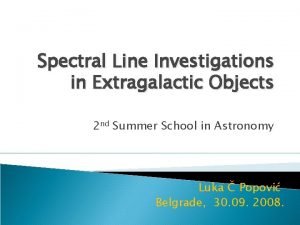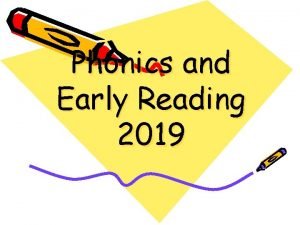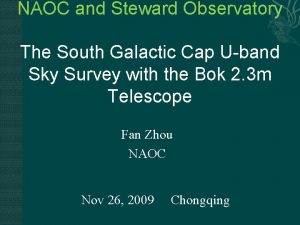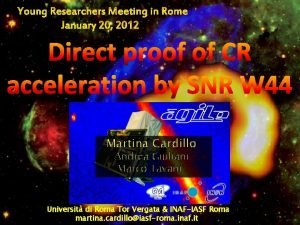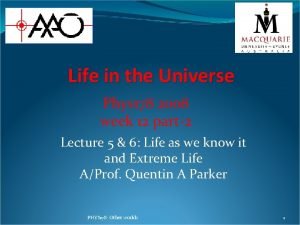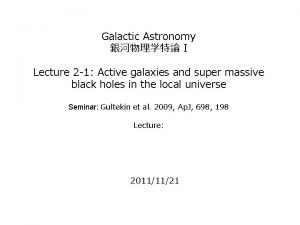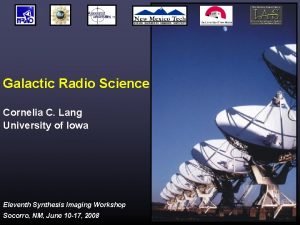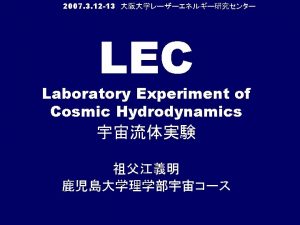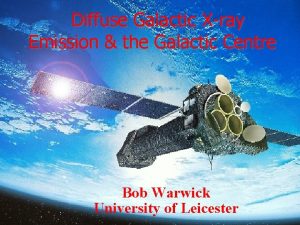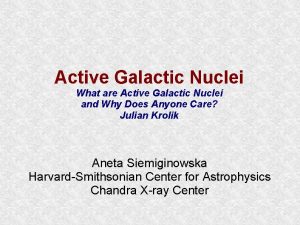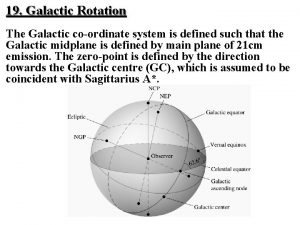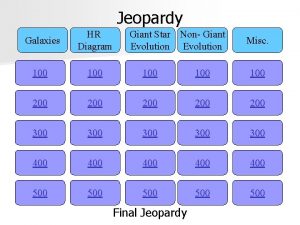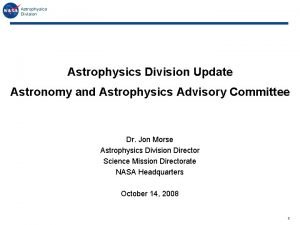Astrophysics of the Galactic Center Part I Giant



![• • Fermi Bubbles 2 x 37 10 erg/s [1 -100 Ge. V] • • Fermi Bubbles 2 x 37 10 erg/s [1 -100 Ge. V]](https://slidetodoc.com/presentation_image/f40dc7392ba9c318892fd6bd9387e93b/image-4.jpg)










































- Slides: 46

Astrophysics of the Galactic Center Part I: Giant Shocks in the Fermi Bubbles and the Origin of the Microwave Haze Roland Crocker ARC Future Fellow Australian National University image credit: NASA

Collaborators • Geoff Bicknell, RSAA • Ettore Carretti, Cagliari Observatory • Andrew Taylor, Dublin Institute for Advanced Studies Details: Crocker et al. 2015 Ap. J, 808, 107; Crocker et al. 2014 Ap. JL, 791, L 20

Fermi Bubbles Su, Slatyer and Finkbeiner 2010 (Ap. J)
![Fermi Bubbles 2 x 37 10 ergs 1 100 Ge V • • Fermi Bubbles 2 x 37 10 erg/s [1 -100 Ge. V]](https://slidetodoc.com/presentation_image/f40dc7392ba9c318892fd6bd9387e93b/image-4.jpg)
• • Fermi Bubbles 2 x 37 10 erg/s [1 -100 Ge. V] hard spectrum, but spectral down-break below ~ Ge. V in SED, cut-off (? ) ~100 Ge. V uniform projected intensity sharp edges vast extension: ~7 kpc from plane ≳ few 55 10 erg coincident emission at other wavelengths

WMAP Haze Su, Slatyer and Finkbeiner Dobler (2012)2010 (Ap. J)

5. -0 � � e z a h e 3 (2 4 4 ➜ v a w o r ic m Slide credit: D. Pietrobon & K. M. Gorski Planck Collab. z H G s i ) D R A H p s t c e : m ru � ∝ � F

Giant Radio Lobes : m d e is 3. 2 z H 2 ➜ G 3 o c t n u in m u is F O S s T e p u r ct o p Carretti et al. 2013 � � ∝ � F r la 2. 3 GHz polarized intensity 0. 1 -�

Fermi Bubbles: Two Interlocking Questions Q 1. What energizes the outflow? SMBH at Sgr A* OR some other nuclear process …nuclear star-formation

Energetics • • • The (photon) Eddington luminosity of Sgr A* (4 x 6 10 M Sun): 5 x Star formation in the Galactic Centre at a rate ~0. 08 MSun/yr (Crocker at al. 2011) …the Galactic Centre is not a Starburst 44 10 erg/s ⇒EXPLOSION This injects mechanical power (supernova explosions, stellar winds) of 51 10 Pmech ~ 0. 08 MSun/yr x 1 SN/(90 MSun) x erg/SN ⇒SLOW INFLATION 40 = 3 x 10 erg/s

A few words about the Central Molecular Zone…

Herschel SPIRE 250 μm (Molinari et al. 2011) 2. 7 GHz radio data (unsharp mask, 9. 4`) Pohl, Reich & Schlickeiser 1992 140 pc Ring collimates outflow ablates cold gas HESS Te. V (Aharonian et al 2006)

Where is the Galactic Centre? Fermi 5 year >1 Ge. V

FIR-RC L 1. 4 GHz = 1. 2 × 19 10 Watt/Hz Yun et al. 2001 Ap. J 554, 803 fig 5 radio in deficit wrt expectation from FIR system is 1 dex (> 4σ) off correlation GC L 60μm = 1. 3 × 8 10 L☀ i. e. GHz radio emission of region only ~10% expected

Ackermann et al. 2012 (Fermi collab) GC

Fermi Bubbles: Two Interlocking Questions Q 2. What is the radiation mechanism? ‘leptonic’: Cosmic ray electrons/Inverse Compton emission OR ‘hadronic’: Cosmic ray protons/gas collisions

Points for/against AGN/IC scenarios • • • PRO: single electron population can explain both the Bubbles’ gamma-ray emission (as IC) and the microwave haze (as synchrotron) PRO: Hα measurements suggest a hard UV “flash” may have irradiated the Magellanic Stream above the nucleus 1 -3 Myr ago (Bland-Hawthorn et al. 2013) [but the Hα emission might also be explained by shocks: Bland-Hawthorn et al. 2007] CON: we are required to be seeing the Bubbles at a privileged time CON: Lack of a bright/hot X-ray edge suggests that Bubbles are expanding, at most, at the sound speed 300 km/s (Tahara et al. 2015, Karaoke et al. 2015) CON: Steep-spectrum polarized radio lobes coincident with Bubbles imply an electron population with age > 3 107 year CON: Difficult to understand why gamma-ray spectrum does not evolve strongly (may even harden) with latitude in an IC model

Points for/against SF/hadronic scenarios • • • PRO: Bubbles’ gamma-ray luminosity requires a source of protons of power ~1039 erg/s in saturation…this is the approximate power supplied by nuclear SF to cosmic rays that escape the GC CON: Secondary electrons can supply microwave synchrotron radiation but predict a too-steep spectrum to explain the haze CON: Structures have to maintain coherence for very long timescales

The Fermi Bubbles as Bubbles Crocker, Bicknell, Taylor & Carretti 2015, Ap. J 808, 107

pa pb pb Ambient medium Shocked ambient medium Shocked bubble Free expansion region 40 ~10 erg/s Nuclear Star Formation Forward shock Contact discontinuity Reverse shock

Expansion of a radiative bubble r y M 0 0 1 into finite (const) pressure w e e f z i r s e t ’ f l a a r e u medium z t i a s t ‘n r i e h t h s e l b b Bu Th d e rv s i e s o cl t e r i e h t o z i s e s b o ’ s e bl ub B e c a re n e r r cu size observed Bubbles Crocker et al. 2015

Mass Drop-Out Crocker et al. 2015

ra con tac t di sco ntin uity di dow nst Haz e rea m IC γ -ray s Haz Rev e Haz e IC γ ers es -ray s hoc k IC γ -ray Fre e ly-e win xpand dz one ing nucleus s o pl um e

Giant Shocks in the Fermi Bubbles • General scenario: adiabaticallyexpanding nuclear wind… • Reverse shock where P = P • Have to incorporate gravity, halo ram pressure & cooling pls height ~ 1 kpc Mach num ~ 6 -9 Crocker et al. 2015

Giant Shocks in the Fermi Bubbles Crocker et al. 2015

pa pb pb Ambient medium Shocked ambient medium Shocked bubble Forward shock ~500 km/s Free expansion region ~700 km/s Nuclear Star Formation Contact discontinuity Reverse shock

GHz radio ra di pl um e con tac t di sco ntin uity o dow nst Haz e rea m IC γ -ray s Haz Rev Haz e IC γ ers IC gamma-rays e es -ray s hoc k IC γ -ray Fre e ly-e win xpand dz one ing nucleus pp gamma-rays s haze microwaves

Parameter Space Bubbles never reach observed size Mass loading typical for SF outflow Bubbles quickly shoot past observed size Crocker et al. 2015

ra di pl um e con tac t di sco ntin uity o dow nst Haz e rea m IC γ -ray s Haz Rev e Haz e IC γ ers es -ray s hoc k IC γ -ray Fre e ly-e win xpand dz one ing nucleus s pp gamma-rays

Hadronic Gamma-Rays from Cooling Shell • Shell dissipates incoming enthalpy flux radiatively • Cosmic rays and magnetic fields adiabatically amplified in cooling shell/filaments • Cooling shell/filaments supported by non-thermal pressure …these assumptions are sufficient to predict the hadronic gamma-ray luminosity: Crocker et al. 2015

Gamma-ray Luminosity pp L�� = LIC = 10% obs L�� LIC = 30% obs L�� Crocker et al. 2015

Synchrotron radiation I: Microwave Haze Crocker, Bicknell, Taylor & Carretti 2015, Ap. J 808, 107

Synchrotron Luminosity 2. 3 GHz luminosity supplied with 20% of CR power going to electrons 2. 3 GHz luminosity supplied with 5% of CR power going to electrons Crocker et al. 2015

Explaining hard haze spectrum pa pb pb Ambient medium Shocked ambient medium Shocked bubble Forward shock ~500 km/s Free expansion region Mach num: M ~ 6 -9 ~700 km/s Nuclear Star Formation Contact discontinuity Reverse shock

Range of CR electrons downstream of shock Crocker et al. 2015

Explaining hard haze spectrum

Synchrotron radiation II: Polarized, steepspectrum radio continuum Crocker, Bicknell, Taylor & Carretti 2015, Ap. J 808, 107

Giant Radio Lobes : m d e is 3. 2 z H 2 ➜ G 3 o c t n u in m u is F O S s T e p u r ct o p Carretti et al. 2013 � � ∝ � F r la 2. 3 GHz polarized intensity 0. 1 -�

Range of CR electrons downstream of shock Crocker et al. 2015

Polarized, steepspectrum emission • lower-energy electrons that reach the magnetised shell synchrotron cool in situ • there is then a mixture of electron populations with different ‘ages’ -3 resulting in ∝ Ee overall electron spectrum (Karadashev) • explanation for the Fν ∝ -1 ν , polarised radio emission

Conclusions With few free parameters our nuclear SF-driven model addresses or explains: • the size of the Bubbles • the luminosity, spectrum and morphology of the Bubbles’ gamma-ray emission • the luminosity, spectrum and extent of the microwave haze of the polarised radio lobes • the power dissipated in the Bubbles is a good match to the mechanical power injected by nuclear SF • the total energy content of the Bubbles is a good match to (nuclear SF power) x (few 100 Myr expansion timescale)

Advertisement: IAU Symposium 322: The Multi-Messenger Astrophysics of the Galactic Centre “The meeting aims to combine results, not just from astrophysics, but also astroparticle physics for the first time. ” Palm Cove, Australia, July 18 -22 2016 go to: galacticcentre. space

Extra Slides

Adjustable Parameters -12 10 2 dyn/cm • ‘Atmospheric’ pressure ~ 3 x • solid angle each conical outflow Ω = π • shock mechanical power going into cosmic rays εCR ~ 0. 15 • fraction of cosmic ray power going into electrons Le/LCR ~ 0. 1


A breeze from Andromeda? Andromeda

north shock? H-alpha south shock
 Galactic centre radio transients
Galactic centre radio transients Nasa astrophysics advisory committee
Nasa astrophysics advisory committee Astrophysics equations
Astrophysics equations Mhd equations
Mhd equations Astrophysics
Astrophysics Astrophysics syllabus
Astrophysics syllabus Time domain astrophysics
Time domain astrophysics Astrophysics
Astrophysics Astrophysics for dummies
Astrophysics for dummies Virial theorem in astrophysics
Virial theorem in astrophysics Rit astrophysics
Rit astrophysics Queen mary astrophysics
Queen mary astrophysics Swinburne astrophysics
Swinburne astrophysics Liverpool astrophysics
Liverpool astrophysics Advanced telescope for high energy astrophysics
Advanced telescope for high energy astrophysics The selfish giant part 2 summary
The selfish giant part 2 summary The selfish giant oscar wilde
The selfish giant oscar wilde Glorck
Glorck African city model
African city model Star wars combine
Star wars combine Sector model example
Sector model example Galatic city model
Galatic city model Reverberation
Reverberation Galactic habitable zone
Galactic habitable zone Active galactic nuclei
Active galactic nuclei Galactic phonics ure
Galactic phonics ure Galactic cap review
Galactic cap review Galactic plane
Galactic plane Galactic habitable zone
Galactic habitable zone Active galactic nuclei
Active galactic nuclei Galactic
Galactic Hình ảnh bộ gõ cơ thể búng tay
Hình ảnh bộ gõ cơ thể búng tay Frameset trong html5
Frameset trong html5 Bổ thể
Bổ thể Tỉ lệ cơ thể trẻ em
Tỉ lệ cơ thể trẻ em Gấu đi như thế nào
Gấu đi như thế nào Tư thế worm breton
Tư thế worm breton Hát lên người ơi
Hát lên người ơi Các môn thể thao bắt đầu bằng tiếng bóng
Các môn thể thao bắt đầu bằng tiếng bóng Thế nào là hệ số cao nhất
Thế nào là hệ số cao nhất Các châu lục và đại dương trên thế giới
Các châu lục và đại dương trên thế giới Công thức tính độ biến thiên đông lượng
Công thức tính độ biến thiên đông lượng Trời xanh đây là của chúng ta thể thơ
Trời xanh đây là của chúng ta thể thơ Cách giải mật thư tọa độ
Cách giải mật thư tọa độ Phép trừ bù
Phép trừ bù Phản ứng thế ankan
Phản ứng thế ankan Các châu lục và đại dương trên thế giới
Các châu lục và đại dương trên thế giới
